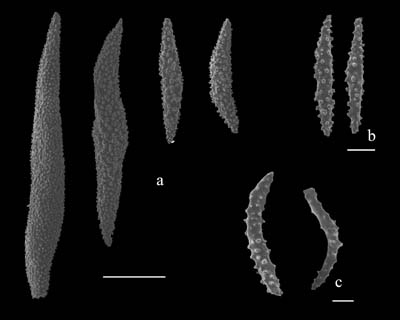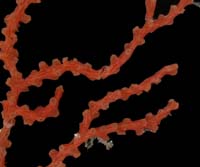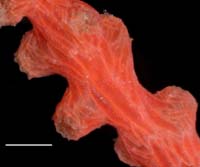CONTENTS
Introduction
The South Atlantic Bight
Methods
Octocoral Morphology
Glossary
Gorgonacean
Bauplan
see this for keys
Notes on the Species
Carijoa
riisei
Scleranthelia
rugosa
Telesto fruticulosa
Telesto nelleae
Telesto sanguinea
Bellonella rubistella
Pseudodrifa nigra
Nidalia occidentalis
Iciligorgia schrammi
Diodogorgia
nodulifera
Titanideum
frauenfeldii
Muricea pendula
Thesea nivea
Bebryce cinerea
Bebryce parastellata
Scleracis guadalupensis
Paramuricea sp.
Leptogorgia hebes
Leptogorgia punicea
Leptogorgia
cardinalis
Leptogorgia virgulata
Leptogorgia setacea
Leptogorgia euryale
Viminella
barbadensis
Renilla reniformis
Sclerobelemnon
theseus
Stylatula elegans
Virgularia presbytes
| Guide
to the Shallow Water (0-200 m) Octocorals of the South Atlantic
Bight.
S. T. DeVictor
& S. L. Morton, 2007
Scleracis guadalupensis
(Duchassaing and Michelotti, 1860) Remarks. Scleracis guadalupensis forms small colonies dichotomously branching in one plane. The specimens examined for this work had a stem width of 1-2 mm and height of a maximum of 4 cm. The cylindrical calyces are very prominent, tending to be biserially arranged along the sides of the stem, but in a twisted manner. Near the opening of the calyces there is an armature of small, warted spindles, and towards the stem the spindles become large (1-3mm) and are orientated longitudinally. The large spindles are densely scattered with fine, spinous warts, except near the acute tips where the warts may become sparse. The examined specimens are coral red in ethanol, but white colonies have been reported (Bayer, 1961). Atlantic distribution: Bermuda, North Carolina, Florida, Gulf of Mexico, 18-184 m; Bahamas, 600-715 m; Mexico, 174-348 m; Caribbean, 50-358 m; Costa Rica, 55-69 m; Brazil, 110 m (Deichmann, 1936; NMNH collections).
|
|
 |


